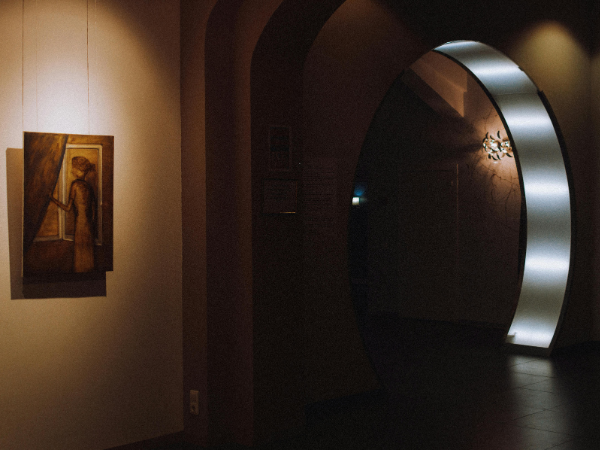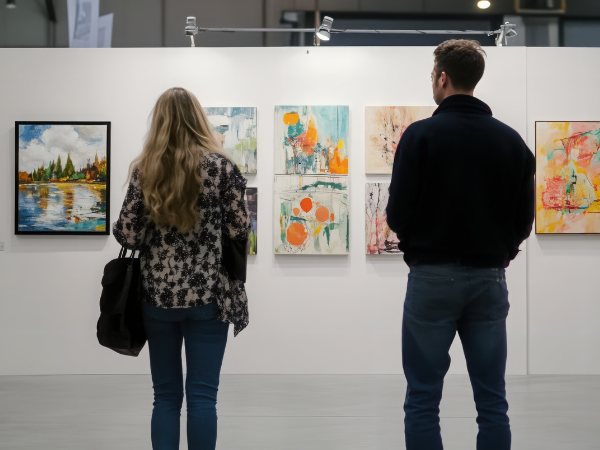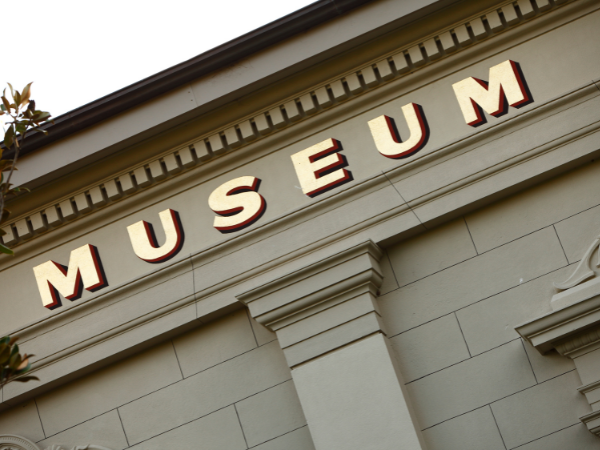The colors pop, details become clearer, and your work feels more inspiring. Choosing the right lights for your art space isn’t just about brightness—it’s about creating the perfect mood and helping your talent shine. Keep reading, and you’ll discover simple tips to pick lighting that makes your art look amazing and keeps you motivated every time you create.
Lighting Basics For Art Spaces
Bright Ideas: Choosing the Right Lights for Your Art Space starts with understanding the basics of lighting. Proper lighting makes your artwork shine and reveals every detail. It can change how colors look and how viewers feel about the art.
Types Of Light Sources
Choosing the right light source is key to creating an ideal art space. There are several types of lights, each with its own benefits and drawbacks. The main types include:
- Incandescent Bulbs: These give warm light but produce heat and use more energy.
- Fluorescent Lights: Energy-efficient but may cause flickering and harsh shadows.
- LED Lights: Long-lasting, energy-saving, and available in various colors.
- Halogen Lamps: Bright and clear, but they get hot and use more power.
Here is a quick comparison table:
| Light Type | Energy Use | Heat Output | Color Quality | Best Use |
|---|---|---|---|---|
| Incandescent | High | High | Good | Warm, cozy lighting |
| Fluorescent | Low | Low | Moderate | General lighting |
| LED | Very Low | Low | Excellent | Task and display lighting |
| Halogen | High | High | Very Good | Highlighting details |
LED lights often work best for art spaces. They produce little heat, save energy, and show colors well. Choose based on your budget and lighting needs.
Color Temperature And Its Effects
Color temperature affects how your art looks. It is measured in Kelvins (K). Different temperatures create different moods and color appearances.
- Warm Light (2700K – 3000K): Gives a cozy, yellowish glow. It makes warm colors like red and orange pop.
- Neutral Light (3500K – 4100K): Balanced white light. It shows colors naturally without strong warm or cool tones.
- Cool Light (5000K – 6500K): Bright, bluish light. It enhances blues and greens and mimics daylight.
Use this table to decide the best color temperature:
| Color Temperature (K) | Mood | Best For |
|---|---|---|
| 2700K – 3000K | Warm, inviting | Traditional art, warm tones |
| 3500K – 4100K | Neutral, clear | Mixed media, natural look |
| 5000K – 6500K | Cool, bright | Modern art, precise color work |
Choosing the right color temperature helps your artwork look true and fresh. It affects how viewers feel and notice details.
Importance Of Cri In Art Lighting
CRI stands for Color Rendering Index. It measures how well a light source shows colors compared to natural sunlight. The scale goes from 0 to 100. A higher CRI means colors look more true and vibrant.
For art spaces, aim for a CRI of 90 or above. This level reveals the real colors and subtle shades in your artwork. Low CRI lights can make colors appear dull or off.
- CRI 80-89: Good for general use but not ideal for art.
- CRI 90-100: Best for art and color-critical tasks.
Always check CRI when buying lights for your art space. Good CRI helps your art look its best and keeps colors true over time.
Natural Vs Artificial Lighting
Choosing the right lighting for your art space is crucial for creating the perfect environment to work and display your creations. Natural and artificial lighting both have unique qualities that affect how your art looks and how comfortable you feel. Knowing the differences helps you pick the best option or combine both for ideal results.
Benefits Of Natural Light
Natural light offers many advantages for art spaces. It provides a full spectrum of colors, making your artwork appear true and vibrant. This light changes throughout the day, giving variety and depth to your workspace.
- True color representation: Sunlight shows colors as they are, without distortion.
- Energy efficiency: It costs nothing and reduces electricity use.
- Improved mood and focus: Exposure to daylight can boost creativity and reduce eye strain.
- Soft, natural shadows: These add dimension to your art.
Here is a simple comparison of natural light features:
| Feature | Benefit |
|---|---|
| Full Spectrum | Shows true colors in artwork |
| Dynamic | Changes with time, adding variety |
| Free | No electricity cost |
| Comfort | Enhances mood and reduces fatigue |
Challenges With Natural Light
Natural light also has some drawbacks that can affect your art space. It is not always reliable since sunlight depends on weather and time of day. This can cause inconsistent lighting, which may disrupt your work.
- Variable intensity: Brightness changes can create glare or deep shadows.
- Limited hours: Daylight is only available during certain times.
- UV damage: Prolonged exposure can fade artwork and materials.
- Space restrictions: Not all rooms have enough windows or direct sunlight.
These challenges require careful planning. You might need curtains, blinds, or UV filters to protect your art and control light levels.
Best Artificial Lighting Options
Artificial lighting offers control and consistency, making it a great choice for art spaces. It allows you to work any time without worrying about weather or daylight changes.
- LED lights: Energy-efficient, long-lasting, and produce little heat.
- Fluorescent lights: Cost-effective but may cause flicker or color distortion.
- Halogen lights: Bright and clear but generate heat and consume more energy.
For the best results, choose lights with a high Color Rendering Index (CRI) above 90. This ensures colors look natural under artificial light.
| Light Type | Pros | Cons |
|---|---|---|
| LED | Energy-efficient, cool, high CRI | Higher upfront cost |
| Fluorescent | Affordable, bright | Flicker, lower CRI |
| Halogen | Bright, good color | Heat, energy use |
Position lights to avoid shadows and glare. Use adjustable fixtures to direct light where you need it most. Combining different light sources can create a balanced, flexible workspace.
Lighting Techniques For Displaying Art
Choosing the right lighting can change how art looks in any space. Good lighting highlights colors, shapes, and textures. It helps people feel the mood the artist wants to share. Lighting techniques for displaying art are key to making your art space inviting and clear. Different types of lights serve different purposes. Knowing these helps you create a perfect setup.
Accent Lighting
Accent lighting is designed to focus light on the artwork itself. It draws attention and makes the piece stand out from the surroundings. This type of lighting uses directional lights like spotlights or track lights. These lights create shadows and highlights that add depth and drama.
Benefits of accent lighting:
- Emphasizes specific artworks
- Enhances textures and details
- Creates visual interest and contrast
- Allows control over light intensity and angle
For best results, use adjustable fixtures. These let you change light direction easily. The ideal color temperature is between 3000K and 3500K. This range shows colors naturally without glare or distortion.
| Accent Lighting Tips | Reason |
|---|---|
| Use LED lights | They produce less heat and protect art |
| Position lights at a 30-degree angle | Reduces glare and unwanted shadows |
| Limit light intensity | Prevents fading and damage to sensitive art |
| Use dimmers | Adjust brightness to match room ambiance |
Ambient Lighting
Ambient lighting provides overall illumination for the art space. It sets the basic light level and mood. This lighting type ensures visitors can see the entire room comfortably. It is usually soft and evenly spread. Common sources include ceiling lights, wall sconces, or natural light.
Good ambient lighting helps reduce eye strain. It creates a welcoming environment that invites people to explore the art. Balancing ambient light with accent lighting prevents harsh contrasts.
Key points about ambient lighting:
- Choose warm white bulbs (2700K to 3000K) for a cozy feel.
- Use diffusers to soften harsh light.
- Install dimmable options to control brightness.
- Ensure light is evenly distributed across the space.
- Consider natural light but control UV rays with filters or curtains.
Balancing ambient and accent lighting creates harmony. Ambient light fills the space, while accent light highlights art pieces. Together, they enhance the viewer’s experience and protect your artwork.
Choosing Fixtures And Bulbs
Choosing the right fixtures and bulbs shapes the mood and clarity of any art space. Proper lighting highlights details and colors without causing glare or shadows. Fixtures control light direction and spread. Bulbs affect brightness, warmth, and energy use. Combining the right fixture with the right bulb brings out the best in your artwork and work area.
Spotlights And Track Lights
Spotlights focus intense light on a small area. They are perfect for highlighting specific artworks or work zones. Spotlights create sharp contrasts and draw attention. Use them to emphasize texture, brush strokes, or small details.
- Adjustable heads allow precise beam aiming.
- Best for accent lighting rather than general illumination.
- Can cause harsh shadows if placed too close.
Track lights offer flexibility and control. Mounted on a rail, multiple lights slide and rotate to light several areas. Track lighting suits dynamic spaces where displays change often.
- Easily reposition lights along the track.
- Supports different bulb types for varied effects.
- Ideal for both spotlighting and ambient light.
| Feature | Spotlights | Track Lights |
|---|---|---|
| Flexibility | Fixed position, adjustable head | Highly adjustable and movable |
| Light Focus | Focused beam, narrow spread | Multiple beams with adjustable spread |
| Use | Highlighting specific art pieces | Lighting multiple artworks or areas |
| Installation | Usually fixed mount | Mounted on rails or tracks |
Spotlights sharpen details. Track lights bring adaptable, broad coverage. Both fixtures enhance your art space but serve different purposes.
Led Vs Halogen Bulbs
Choosing the right bulb affects the quality, energy use, and lifespan of your lighting. LED bulbs use less energy and last longer than halogen bulbs. They produce less heat, protecting sensitive artwork. LEDs offer various color temperatures, from warm to cool light.
Halogen bulbs emit bright, white light close to natural daylight. This helps see true colors but they use more energy and get hotter. Over time, halogen bulbs need frequent replacement.
| Bulb Type | Energy Use | Heat Emission | Lifespan | Color Quality |
|---|---|---|---|---|
| LED | Low | Low | 25,000+ hours | Varies (2700K–6500K) |
| Halogen | High | High | 2,000–4,000 hours | High (closer to daylight) |
- LED bulbs reduce energy bills and heat build-up.
- Halogen bulbs provide excellent color rendering.
- LEDs come in dimmable versions for mood control.
- Halogen bulbs require careful placement due to heat.
LEDs suit long-term use with flexible lighting effects. Halogens shine where natural color accuracy is critical and short-term use is planned.
Avoiding Common Lighting Mistakes
Choosing the right lights for your art space can change how your artwork looks and feels. Bright, clear light helps you see every detail. Poor lighting can hide colors or create unwanted effects. Avoiding common lighting mistakes ensures your art shines in the best way. These errors can distract viewers and damage your pieces.
Glare And Shadows
Glare happens when light reflects directly into your eyes or on your artwork. It can make it hard to see details or colors. Shadows form when an object blocks light, causing dark spots on your art. Both problems reduce the quality of how your art looks.
Common causes of glare and shadows:
- Using too many bright lights close to the art
- Placing lights at wrong angles
- Not using diffusers or soft lighting
- Lights that are too harsh or direct
Tips to avoid glare and shadows:
- Use adjustable lamps to control light direction.
- Place lights at a 30-degree angle to your art.
- Install soft or diffused light bulbs.
- Mix ambient light with focused spotlights.
| Problem | Cause | Solution |
|---|---|---|
| Glare | Direct bright light on shiny surfaces | Use matte finishes and angle lights |
| Shadows | Light blocked by objects or wrong angle | Adjust light position and add fill lights |
Overexposure And Fading
Overexposure means too much light shines on your artwork. It makes colors look washed out and details hard to see. Long-term overexposure can cause fading. Fading happens when light breaks down paint and paper. It damages your art over time.
Signs of overexposure and fading:
- Colors lose brightness
- Paper or canvas looks yellowed or brittle
- Paint or ink peels or cracks
Ways to prevent overexposure and fading:
- Use LED lights with low UV output.
- Limit light exposure time each day.
- Keep artworks away from direct sunlight.
- Use UV-filtering glass or acrylic frames.
Choosing the right lights makes your art space shine. Good lighting shows colors clearly and keeps your eyes comfortable. Soft, bright lights help you see details well.




